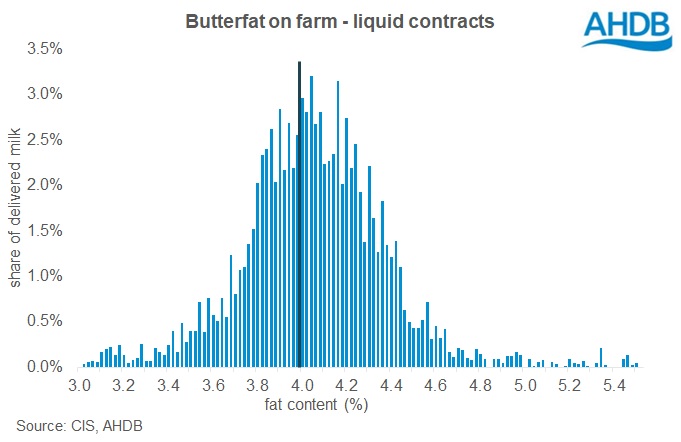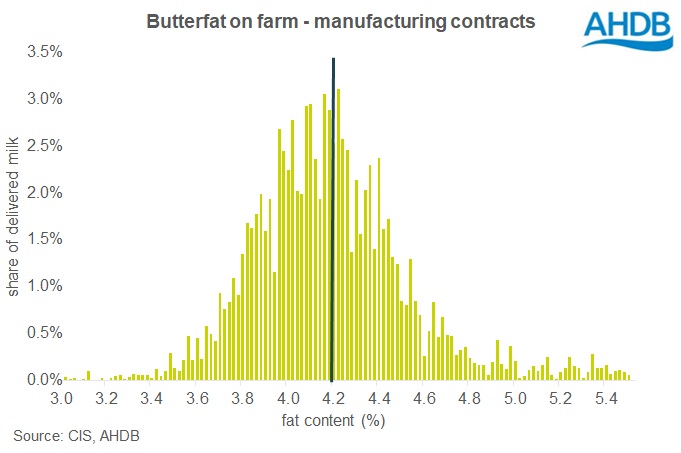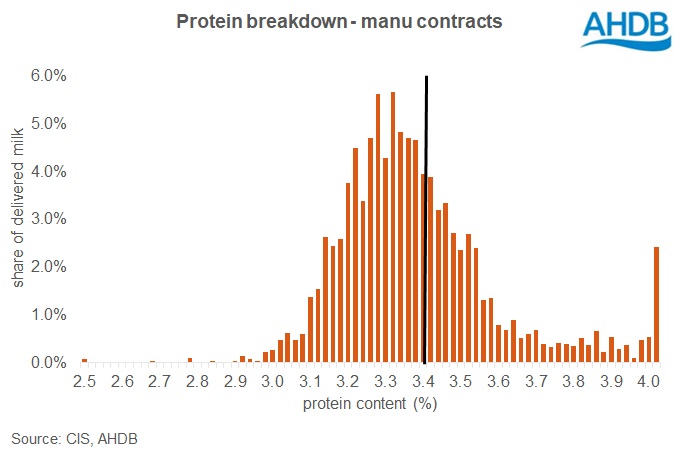Is there room to boost your milk cheque?
Thursday, 7 October 2021
By Patty Clayton
Milk delivered below buyer specifications for butterfat and protein could be costing GB dairy farmers as much as £55 million a year in lost revenues, the equivalent of 0.44ppl[1].
The butterfat and protein content of milk provides value to processors, and most buyers will design their pricing schedules to incentivise farmers to deliver what they need to generate value in their markets.
Butterfat
Butterfat is almost universally valuable to processors, whether they are producing cheese, bottled milk, yoghurt or milk powders. In most cases, the value of surplus butterfat will be the market return for cream or butter, because any excess fat can be skimmed off and sold separately.
Almost all buyers pay for additional fat above a defined base level, yet an assessment of the butterfat levels produced on farm during the 2020/21 milk year suggests many farmers are not benefitting from this.
The chart below is taken from a sample of milk delivered to milk buyers, all of which pay for butterfat. Over 40% of the milk destined for the liquid market was delivered with a butterfat level of less than the base level of 4%. For milk destined for manufacturing, the typical base level for butterfat is slightly higher at 4.2%, and around 55% of the milk delivered for manufacturing fell below this level.
If this milk had reached the desired butterfat levels, it would have generated in the region of £38m of additional income at farm level[2].


Protein
Liquid milk processors are not able to capture value from the market for additional protein, and therefore do not typically include payment for surplus protein above the base level. Farmers supplying into this sector do not achieve any benefit from producing additional protein, but could incur added costs on-farm. In the 2020/21 milk year, over 40% of the milk destined to the liquid market exceeded 3.3%, the typical base level requested by buyers.
Manufacturers of dairy products can benefit from additional protein, and typically pay for milk delivered above a base value of 3.4%. Based on the sample of delivered milk, around 64% of the milk missed this target, effectively forfeiting an estimated £17m in payments.

What can farmers do about it?
These figures include milk delivered throughout the year, including months when butterfat and protein levels are typically low as a result of seasonality. It is recognised that increasing butterfat and protein throughout the year is not always easy and will come at a cost.
Farmers supplying liquid contracts will often have the added complication of being paid for additional butterfat but not for additional protein. Feeding for higher butterfat levels without also increasing protein can be challenging, and, in theory, any protein above the minimum level is wasted resource.
With many input costs at high levels, with the potential to keep rising, now is a good time to do the cost-benefit analysis of pushing for higher solids; if it works now, then it is highly likely to be the right decision for the long term.
For example, at current payment rates, a 1.5 million litres per year farm increasing butterfat content from 4.0% to 4.1% would generate around £3,600 of additional revenue per year on average (equivalent to 0.26ppl). Depending on milk contract, this can reach as high as £5,400 per year. It is important to assess the potential benefit based on your own circumstances and pricing schedule. The AHDB milk price calculator can be used for that assessment. It allows farmers to see how changes to the constituents in their milk will impact their milk cheque. Matching this up against the additional costs of achieving higher solids through the use of a partial budget will determine whether pushing for solids is the right route for your farm.
Longer term, farmers can choose to breed for higher constituent cows. AHDB’s herd genetic report is available to all farmers who milk record, and provides all the necessary information on your current herd to match your breeding decisions to your desired outcomes.
Farmer checklist to increase milk solids from dairy cows
- Use AHDB’s milk price calculator to see how changes to constituents affect your milk cheque
- Review your feeding approach and ration with your nutritionist or vet
- Work out a partial budget to see whether the costs to increase solids outweigh the additional revenues
- Longer-term, breed from bulls who are likely to pass higher constituent genetics to cows. AHDB’s herd genetic report allows you to see your herd’s strengths and weaknesses and make informed breeding decisions.
[1] Not including any monies lost due to missing quality targets on somatic cell counts and bactoscan
[2] This does not account for the additional cost of feeding for higher butterfat
Sign up to receive the latest information from AHDB.
While AHDB seeks to ensure that the information contained on this webpage is accurate at the time of publication, no warranty is given in respect of the information and data provided. You are responsible for how you use the information. To the maximum extent permitted by law, AHDB accepts no liability for loss, damage or injury howsoever caused or suffered (including that caused by negligence) directly or indirectly in relation to the information or data provided in this publication.
All intellectual property rights in the information and data on this webpage belong to or are licensed by AHDB. You are authorised to use such information for your internal business purposes only and you must not provide this information to any other third parties, including further publication of the information, or for commercial gain in any way whatsoever without the prior written permission of AHDB for each third party disclosure, publication or commercial arrangement. For more information, please see our Terms of Use and Privacy Notice or contact the Director of Corporate Affairs at info@ahdb.org.uk © Agriculture and Horticulture Development Board. All rights reserved.

